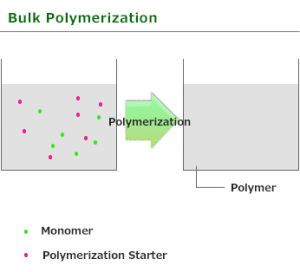Bulk polymerization
Bulk polymerization or mass polymerization is carried out by adding a soluble initiator to pure monomer in the liquid state. The initiator should dissolve in the monomer. The reaction is initiated by heating or exposing to radiation. As the reaction proceeds the mixture becomes more viscous. The reaction is exothermic and a wide range of molecular masses are produced.
Bulk polymerization is carried out in the absence of any solvent or dispersant and is thus the simplest in terms of formulation. It is used for most step-growth polymers and many types of chain-growth polymers. In the case of chain-growth reactions, which are generally exothermic, the heat evolved may cause the reaction to become too vigorous and difficult to control unless efficient cooling. Bulk polymerization has several advantages over other methods,
Advantages of Bulk Polymerization:
- The system is simple and requires thermal insulation.
- The polymer obtained is pure.
- Large castings may be prepared directly.
- Molecular weight distribution can be easily changed with the use of a chain transfer agent.
- The product obtained has the high optical clarity
Disadvantages of Bulk Polymerization
- Heat transfer and mixing become difficult as the viscosity of reaction mass increases.
- The problem of heat transfer is compounded by the highly exothermic nature of free radical addition polymerization.
- The polymerization is obtained with a broad molecular weight distribution due to the high viscosity and lack of good heat transfer.
- Very low molecular weights are obtained.
- Gel effect should be there
For reducing the disadvantages of bulk polymerization, the process can be carried out in a solution. This is known as solution polymerization.
Polymer characterization is the analytical branch of polymer science.
The discipline is concerned with the characterization of polymeric materials on a variety of levels. The characterization typically has as a goal to improve the performance of the material. As such, many characterization techniques should ideally be linked to the desirable properties of the material such as strength, impermeability, thermal stability, and optical properties.
Characterization techniques are typically used to determine the molecular mass, molecular structure, morphology, thermal properties, and mechanical properties.


